Many people have written about this dress, which Gilbert Adrian designed for Joan Crawford to wear in the film Letty Lynton, in 1932.
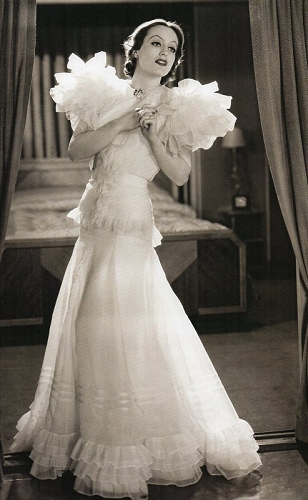
Joan Crawford in “the Letty Lynton dress” designed by Gilbert Adrian. 1932. Image from Creating the Illusion, by Jorgensen and Scoggins.
The “Letty Lynton dress” is usually mentioned as the first movie fashion to be widely copied and sold all over the U.S. — a sign to manufacturers and store buyers that Hollywood could be more influential than Paris when it came to women’s clothing.
“The first time I became conscious of the terrific power of the movies was some months after Letty Lynton was released. I came to New York and found that everyone was talking about the Letty Lynton dress. I had to go into the shops to discover that of all the clothes I had done for Crawford in that film, it was a white organdie dress with big puffed sleeves that made the success. In the studio we thought the dress was amusing but a trifle extreme. The copies of it made the original Letty Lynton look very modest and shy.” — Adrian, quoted in Creating the Illusion, p. 142.
I don’t have any Butterick pattern photos from 1933, but the influence of the Letty Lynton dress can be found in this 1933 advertisement for the Woman’s Institute dressmaking course:
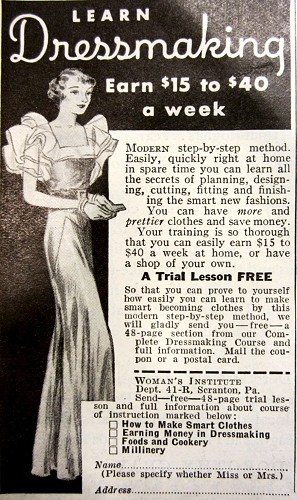
Woman’s Institute ad, 1933. The style chosen to advertise this correspondence course in dressmaking has Letty Lynton’s ruffled organdy sleeves.
Here are some Letty Lynton-inspired dresses from the Sears catalogs, 1933 and 1934.
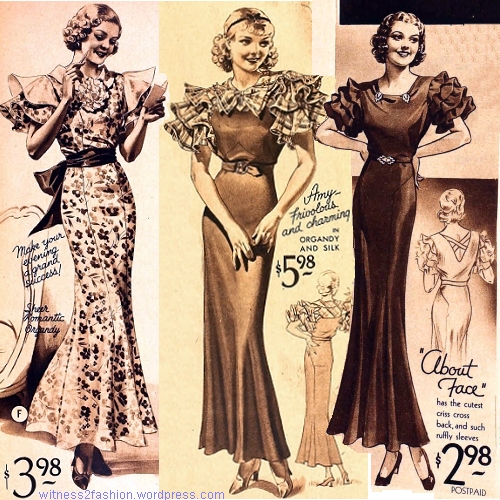
Three “Letty Lynton” style dresses; from Sears catalogs, 1933 and 1934. “Sheer Romantic Organdy” and “such ruffly sleeves.” “Frivolous and charming.”
Before Letty Lynton, the ideal 1930’s evening gown for young women was usually bare and slinky:
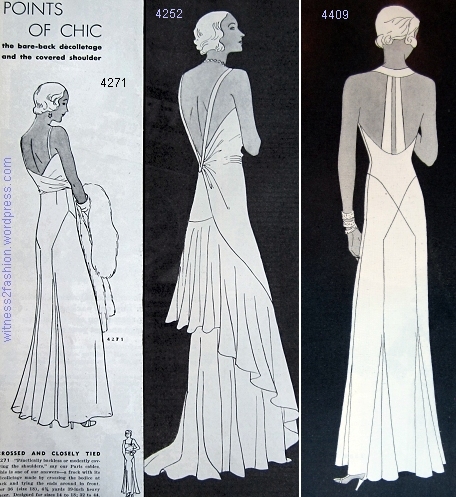
Evening gowns from Delineator, January and March, 1932. Butterick patterns 4271, 4262, and 4409. Notice how wide the models’ shoulders are drawn in relation to their hips!
In 1932, women’s dresses were clinging to their waists and breasts, in a way that had not been seen since before World War I. The horizontal hip line of the nineteen twenties had made even thin women look wider. In the thirties, bias-cut dresses clung to a natural, curvy body, sometimes improved by the new, soft girdles and bras made with lastex. But the average woman still couldn’t achieve the narrow-hipped ideal thirties’ figure.
Apparently, women who saw Letty Lynton (released in 1932) fell in love with the romantic look of Letty’s dress. And with the way it made her hips look smaller.

All four dresses have widened the shoulders with ruffles, or a wide collar, or short sleeves. Butterick patterns 5739, 5726, 5741, 5745.

A black satin dress with huge, ruffled shoulders. Butterick 5581, from March 1934. The illustrator has drawn realistic hips!
No. 5581: “A wear-it-to everything evening frock? It should be dark — but frivolous!” Delineator, March 1934.
If you already had an evening gown, you could bring it up to date with this cape:
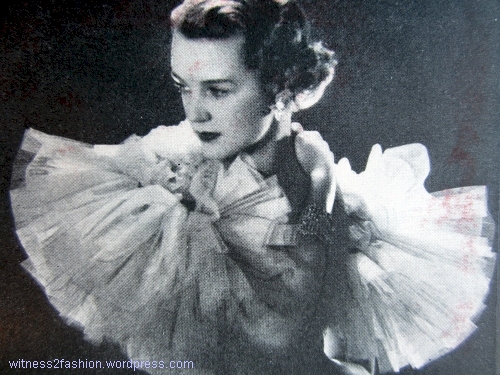
“Pink Maline: Frothy yards of it in a cape that’s chic frosting for a dark evening dress.” Delineator, May 1934 . Maline is netting, like tulle.
The (Pre-Code) plot of Letty Lynton stars Crawford as a woman who leaves the man she has been living with, falls in love, and wants to start a new life — or die. Her white organdy confection of a dress is girlishly innocent, compared to the slinky wardrobe she wears as a sexually uninhibited woman. The organdy dress is extreme, and extremely flattering.
Part 2: Were the Letty Lynton dress, Joan Crawford’s shoulders, and Adrian’s designs responsible for women’s shoulder pads in the 1940s?

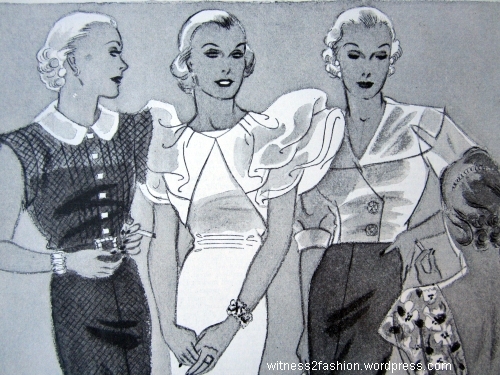
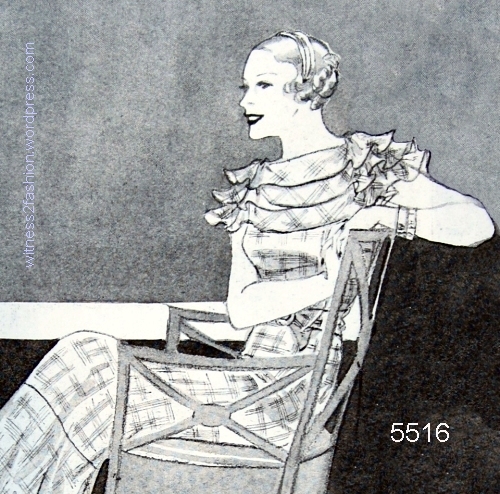
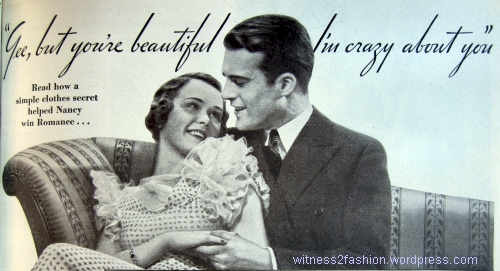

I’m under the impression that there were authorized copies of this dress sold in certain department stores. Did you come across this in your research? And I am fascinated by big shoulders in women’s clothes, especially their rebirth in the eighties.
I only know what Adrian — the designer — said, and I quoted him. He appeared to be surprised, but — hey — Hollywood? Publicity machines? I spent yesterday at the library, going through all Delineators for 1933, and found lots of “influence” but no exact copies. A real researcher would be looking for store advertising. Letty Lynton’s general release was in May, 1932, so dresses could have been copied and in the stores by fall or winter of that year. It’s a rare movie, because litigation has prevented it from being re-released for TV or festivals.
I am seeing articles about broader shoulders in Delineator in 1933 — first, in the form of very full sleeve caps and a revival of leg-o-mutton sleeves…. Now I have a few hundred more digital photos to label and share. I love to hear from you, because you always remind me that I am a dilettante, raising issues for real scholars to pursue. I try not to get sidetracked from my main goal of sharing fashion images and articles from a source that has not been properly digitized. So I am a waterskater, skimming quickly above the stream.
The funny thing is, no copies of this replica have been found, and fashion historians have been searching for decades. There is ONE photo that MIGHT be good a woman wearing a copy several years later, but I don’t think it’s the right dress. It’s very, VERY odd that a dress that supposedly sold 50k in the New York Macy’s alone, has basically disappeared from this planet. You have a better chance of getting to see this movie than of finding this dress. Take it from someone who has a fairly decent copy of the movie, but who can’t track down this dress for the life of me. Part of me suspects that they claim was a publicity stunt.
Pingback: The Letty Lynton Dress, Adrian, and Joan Crawford’s Shoulders: Part 2 | witness2fashion
Pingback: Butterick Starred Patterns: Actual Fashions from the Movies (Part 1) | witness2fashion
Pingback: Butterick Starred Patterns Part 4: Katharine Hepburn and Helen Chandler | witness2fashion
Pingback: An Emerald Mid-1930’s Vionnet Gown | Seam Racer
Pingback: Her Summer Love — 1933 | witness2fashion
Pingback: Butterick Vacation Wardrobe for $25, 1933 | witness2fashion
Pingback: More Ads for Woman’s Institute from 1920’s and 1930’s | witness2fashion
Pingback: The Dress that Launched a Thousand Sleeves | The Vintage Traveler
Pingback: Channeling Crawford’s Adrian | Seam Racer
Pingback: Replacing Your Sleeves to Update Your Dress (and Sometimes Widen Your Shoulders) | witness2fashion
Pingback: Directoire Sleeves, 1929 and 1930 | witness2fashion
Pingback: Boleros Part 3: Day and Evening, 1930s | witness2fashion